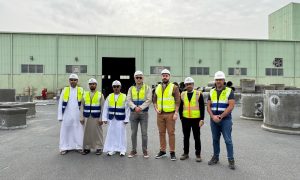Jonathan Lock, ARUP Taskforce
Which projects have you used BIM for and how its application change your working processes compared to not using BIM? BIM is not a single product or service, it is a descriptive term for the technologically advanced, collaborative and information-centric processes now being applied to building design. Aspects of what has now become known as […]

Which projects have you used BIM for and how its application change your working processes compared to not using BIM?
BIM is not a single product or service, it is a descriptive term for the technologically advanced, collaborative and information-centric processes now being applied to building design.
Aspects of what has now become known as BIM have been applied to landmark building projects for a long time. Recent examples such as the Beijing Olympic Stadium, Singapore Sports Hub and Water Cube show what can be achieved by working in a more integrated and technology driven way.
The focus of BIM development within Arup over the last 2 years has been to take this cutting edge work and weave it into the everyday projects. This has resulted in a focussed increase in the skills and capabilities of our design teams and an improvement in the way projects are delivered. This is little BIM, the internal focus on quality, efficiency and productivity improvement.
As the industry becomes more aware of the opportunities and benefits of this way of working it becomes possible to do big BIM, with a focus on integrating the wider project team delivering project wide benefits that target the overall cost, value and performance improvements now demanded by our clients.
Some scale of BIM is now applied to everything we do from the standard use of 3D modelling and documentation technology to the introduction of BIM coordinator roles and the creation of project wide protocols to drive increased collaboration and coordination.
Within my group a number of projects such as Qatar National Museum and the Leadenhall Tower located in central London have used these BIM developments from other projects and incorporated to deliver coordinated BIM models which are being used by the Main Contractors for construction phases of work.
Perhaps the biggest single change we are noticing is an increased level of dialogue between consultants, contractors, architects and clients about how information is created and managed throughout the lifecycle of the project. Critical discussions and planning sessions are taking place earlier in the project cycle as the wider team seeks the benefits of increased collaboration.
What kind of reaction does BIM get in the wider construction industry/ within ARUP and how has this developed over the years?
Within Arup there has been a gradual change in the way BIM is perceived. BIM development was originally driven by the pioneering designers and technicians that were making use of the new technology and modelling tools that were emerging. However this technical focus has shifted into a business focus as the wider management and collaboration aspects of BIM are becoming better understood. Our pioneers are now the people fulfilling BIM coordination roles and developing workable BIM protocols for wider project teams.
Out in the wider industry there has been a definite shift of focus recently away from talking about the potential benefits of BIM and towards finding practical ways to deliver them. A lot of this is due to clients becoming more aware of BIM and what it could do for them and so the industry is being pulled towards widespread adoption of BIM in that way.
How do forums such as BuildingSMART benefit their members?
BuildingSMART is a cross-industry organisation whose mission is to contribute to sustainable built environment through smarter information sharing and communication. There are buildingSMART chapters around the world, with the UK chapter one of the oldest. Building information modelling (BIM) is at the heart of the ‘building smart’ approach. We support collaborative working and the use of BIM on projects. A rich informative 3D model of the project – or BIM – is created, using the open IFC standard, with input from all the project participants. More of the work is done upfront, removing problems further down the line and allowing smooth progress once work starts on site. We encourage new BIM users to identify pilots and deploy a partial BIM to gain familiarity. We stimulate experienced users to continue their rollout of BIM, extend its application and share their experiences.
BuildingSMART created the open IFC standard – a complex feat of IT development – but as a customer-driven organisation, we also put a strong emphasis on user experience, with user, implementers and model support groups. We provide a framework for helping construction and FM firms adopt improved ways of working.
The rewards for clients, investors and building users are buildings that meet real needs, providing better value for money and greater return on investment. Our rich IFC standard and the collaborative style that we promote lead to smart efficient working, with seamless exchange of information. The use of BIM allows swift analysis of the building designs – costs, energy efficiency and maintenance issues – allowing truly sustainable buildings to be designed and constructed.
There are a range of benefits to Arup in joining BuildingSMART, and Arup are already involved with them in Australia and Middle East. Membership presents Arup with the opportunity to benefit though closer association with other BIM-enabled construction firms and the major software vendors to drive process and technology improvement, and though involvement in industry events that will put our expertise in front of key client organisations.
- Access to a range of information and research material
- The opportunity to learn from other members
- Involvement in BuildingSMART International working meetings and conferences
- Networking and business generation opportunities
- Free entry or generous discounts to events and workshops
- Enquiry service
How significant is it that the Jordanian government has taken the “BIM oath?” what will this mean for the local industry and can you see this spreading throughout the industry across the wider region?
This is a vital step for the Middle East region that a government has taken the initiative to take on board BIM and have it as part of its standards. In other parts of the works i.e GSA in the USA, Senattii in Finland, BCA in Singapore all have seen the value of taking the BIM Oath. The industry needs a leader and nothing better than a government body to take that to the industry. This will mean that all government projects shall have a BIM requirement (BIM specification). The government is looking at the lifecycle of a project and with BIM they can reach the desired goals for sustainability as well as ensuring the operational management of the facility is best controlled as costs implications can be seen in the early stages of planning.
How willing are construction professionals to adopt new practices?
BIM is undoubtedly the future of the construction industry and just like health & safety and sustainability have, it will eventually become engrained in the fabric of all construction projects.
Designers are currently leading the adoption wave by implementing the technology and processes of the ‘Little BIM’ world that come from a need to meet the challenges of designing better buildings in more efficient and sustainable ways. This world brings incremental benefits to the individuals and groups engaged in BIM practices resulting from continual technology improvements.
The challenge is expanding this out into the ‘Big BIM’ world whereby the whole supply chain is engaged to shift the focus on to the large scale process improvements that will bring about the project wide benefits.
While there are pockets of BIM development occurring post-design stage on projects it is unlikely to take hold fully until clients are driving the need for it and thereby creating a clear and obvious business case for adoption. However, this needs to be in the hands of educated clients initially who are both setting a requirement for BIM and providing a framework for it to happen through.
The UK government is currently making steps in this direction in its role as a major client to the UK construction industry and the work of Paul Morrell’s team appears to be adding enough depth to the process to ensure that a workable framework for BIM will be created.
When this happens and other major clients start to follow suit then market forces will drive widespread BIM adoption and contractors (and their BIM engaged supply-chains) will bridge the gap between design and delivery to complete and end-to-end BIM process.
This is not to say there are not advantages to early adoption of BIM beyond the design stage, but at present BIM is a maturing subject and so the current economic situation makes it hard to see those advantages beforehand in order to make the case for the necessary investment. This over time will change as more successful projects are delivered in a BIM environment incorporating any lessons learnt.
What are the main barriers to adopting BIM/ joining such bodies and how could these be tackled, in your personal opinion?
Think there are three main barriers that still need to be resolved or at least improved before adoption of BIM becomes consist throughout the industry.
Interoperability and data exchange is perhaps the biggest current issue. The sharing of information between these different models — is critical to the collaborative use of BIM, by assuring that each model consistently represents the same building. However, current technology does not yet allow seamless coordination between different BIM applications. The use of multiple models undermines the collaborative use of BIM and prevents project parties from reaping the full benefits of BIM’s capabilities.
Risk Management with potentially design teams that may have a policy of not sharing BIM information as a risk management strategy, particularly in the context of data accuracy, this then leads onto the ownership of BIM models and who will inevitable be responsible.
People, Training and skills – The lack of knowledge and training across the supply chain is a major barrier, with training critical to increasing BIM implementation.

























